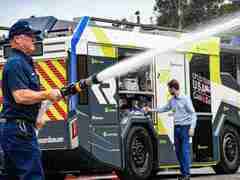Study finds driving behavior can be an indicator of dementia
A recent study has found that driving behavior can be a strong indicator that someone is suffering from mild cognitive impairment (MCI) or dementia.

The study, published in the Geriatrics journal , used driving data, demographic information, and machine learning to predict — with 88% accuracy — whether an individual has MCI or dementia.
Now, driving data on its own is not the most accurate measure of whether someone is experiencing these kinds of cognitive impairments.
Driving data alone can only predict this with 66% accuracy. However, when it’s coupled with demographic data — such as age, race, gender, and education level — the accuracy rises to 88%.
Predictors of MCI or dementia
Age was the leading predictor of MCI or dementia, but a number of driving characteristics also proved to be good indicators.
According to the study, this includes things like the number of trips within 15 miles of home, the length of trips, and the number of hard braking events can also be signs.
To come to these conclusions, the researchers used data from a long-term study called LongROAD , which has tracked nearly 3,000 drivers for four years.
However, the study says that not many individuals with MCI or dementia were found in the LongROAD dataset.
So while the researchers‘ model has managed to predict cognitive impairment with some reliability, it requires much more data before it can be considered robust.
Researchers of this latest study suggest that their machine learning model could be incorporated into a smartphone app or vehicle systems to monitor driving behavior and suggest if the driver is experiencing MCI or dementia.
If you want to read the full study, check it out for yourself here .
HT – New Atlas
Do EVs excite your electrons? Do ebikes get your wheels spinning? Do self-driving cars get you all charged up?
Then you need the weekly SHIFT newsletter in your life. Click here to sign up .
Norway responds to GM and Will Ferrell’s EV challenge… with mackerel-slapping?
Nothing gets the Yanks riled up quite like when another country is doing something better than they are.

General Motors played into that trope with its latest commercial by showing off how much better Norway is at doing EVs than the US is.
It comes across more as a call to arms for the US to take the electric vehicle fight to Norway, but really, it’s just a cleverly disguised advert showing off key GM EVs, that are still some years away from sale.
It also had Will Ferrell in it, people seemed pretty pumped about that. Of course, it was a hoot and a half, it’s just Ferrell being Ferrell, doing Ferrell things. It’s clever, and it’s fun. If you haven’t seen it check it out below:
Okay, Will Ferrell is funny, but what’s the actual context? Well, Norway now sells more electric vehicles than it does combustion engine equivalents. Think about that, more than 50% of new vehicles sold are electric. In the US that figure is still under 5% .
It’s a rare occurrence, but in this instance, the US is very much the underdog in the fight. Even though GM does a good job of making it seem otherwise, the American car giant doesn’t just have an ocean to cross to beat Norway, it’s got to climb from the depths of the Mariana Trench to the top of Mt. Everest if it’s to catch up with Norway.
For exactly that reason, Norway isn’t bothered in the slightest, but it does seem bemused and entertained by Ferrell’s challenge. It’s welcoming the competition, and sending its own messages back to the US, shrugging off and welcoming America’s efforts.
Norwegian university, Universitetet i Agder, made an “apology,” in an attempt to repair Norwegian-American relations. It also made a series of other humble brags about other cool stuff Norway has that the US doesn’t like healthcare, a year-long paid maternity leave, and free education. They had to get political didn’t they.
Check out the university’s rebuttal below.
Easee , a Norway-based company that makes electric car chargers also muscled in on the opportunity to piggy-back on the interest sparked by GM.
Apparently, Easee has installed an EV charger just for Will Ferrell! How considerate, even if it does seem to be in the middle of a frozen lake.
Once Will Ferrell figures out how to get to Norway, because his geography is terrible, and he’s currently stranded in Sweden, at least he’s got somewhere to plug in his General Motors EV that doesn’t even exist yet.
On that point of Will Ferrell’s terrible geography, Norwegian tourist board, Visit Norway, decided it would give him a helping hand and rally a bunch of children to teach him about where stuff is in the Nordics.
The youngsters even throw down the gauntlet and challenge Will Ferrell to a mackerel slapping contest. I’m not sure what that is, but it doesn’t sound like something a Hollywood celebrity should engage in.
Of course, carmakers also took the opportunity to throw some shade at GM and Ferrell.
In a three-part series of bizarre videos, Audi’s Norwegian arm sought to set the record straight for Ferrell and his cronies. Links to each video are here , here , and here . But I’ll share just one, which is by far the weirdest of the lot.
In it, you’ll see Tormund Giantsbane — yup, the red-haired dude from Game of Thrones — tell Will Ferrell that love is not the answer, but that Norway will meet his fight, with a slap in the face, not with mackerel but with a salmon. You have to see it to believe it.
Y’know, there’s been so much noise in response to GM’s advert, and it’s all happened so fast, it’s as if the whole thing was planned that way. Or maybe EV marketing is just getting that good?
Either way, it looks like it’s got EVs in front of more eyes than any ad campaign to date — and I’m all for it.
SHIFT is brought to you by Polestar. It’s time to accelerate the shift to sustainable mobility. That is why Polestar combines electric driving with cutting-edge design and thrilling performance. Find out how .
LA just got America’s first electrified, tech-packed fire truck
This article was originally published by Martin Banks on Clean Fleet Report , a publication that gives its readers the information they need to move to cars and trucks with best fuel economy, including electric cars, fuel cells, plug-in hybrids, hybrids and advanced diesel and gasoline engines.

Another niche filled by an electric version
Electric cars, trucks and buses are slowly making their way onto roads. There have been more than 7.2 million electric vehicle sales to date. As technology advances, there will be even more. Hybrid and fully electric vehicles are already available for a variety of commercial and personal uses.
However, it wasn’t until recently that innovators began to apply electric technology to emergency vehicles. Now, the Los Angeles Fire Department (LAFD) is showing off North America’s first electric fire engine from Austria-based Rosenbauer Group.
Making history
The “Revolutionary Technology” (RT) concept fire truck first became a reality last year, when the LAFD purchased the truck for $1.2 million. Now, the fully networked engine is touring the country and boasting innovative safety features, excellent driving dynamics and superior maneuverability.


However, the vehicle isn’t fully electric. It’s a series plug-in hybrid like the Chevrolet Volt. Volvo Penta , which has created electric powertrains for a variety of applications, will power the Revolutionary Technology fire truck. The electric drive unit is based on one use in terminal tractors. To test durability, Rosenbauer will also test three more trucks in Berlin, Amsterdam and Dubai. The company indicated the unit will begin serial production as early as next year.
The truck features two electric motors with a total output of 490 horsepower and off-the-chart torque. As with most electric vehicles, it offers a low center of gravity for great cornering stability. An additional option is an integrated drone that could be used to scope out the situation out of sight of a fire.
How do electric engines compare?
Are electric fire trucks any better than traditional engines, though? In terms of power, gas- or diesel-powered engines win every time.
The truck is loaded with technology
However, electric trucks are quieter, which allows the fire rescue team to communicate clearly and effectively at the emergency scene. Because the electric drive train ensures little fuel combusts while driving, the RT also reduces emissions, making it an eco-friendly alternative to traditional diesel trucks.
Like traditional fire engines, electric trucks are pumper tankers that can provide relief during fires. However, they also feature a connected mobile command unit, an adjustable ride height and built-in quick-charge batteries with a charging capacity of 100 to 150 kilowatts.
A range extender allows the RT to extend its electrical driving range, so it is not limited to its all-electric range.
The future of electric emergency vehicles
It may be a few years before a full fleet of electric fire trucks makes its way to the U.S. In the meantime, you may see other electric emergency vehicles on the road, like the new zero-emission Nissan ambulance. This vehicle relies on two lithium-ion battery packs and can even act as a mobile power source during power outages and natural disasters.
Various other companies are currently designing and developing fleets of fully electric emergency vehicles, including golf carts for police and ATVs for search-and-rescue operations. However, many of these vehicles must undergo dozens of tests and simulations before they’re road-ready.
A Slow but Sure Transition
Fewer than one percent of the 250 million vehicles on America’s roads are electric. However, as automakers shift to producing electric cars, trucks and SUVs, electric vehicles could account for 25 percent of new sales by 2035 by some estimates. That’s the point California and other states are mandating all new light-duty vehicles for sale must produce zero tailpipe emissions (ZEVs). The state also mandated that, where feasible, all heavy-duty on-road and off-road vehicles also should be ZEVs. Still, slow fleet turnover means most vehicles on the road will run on gasoline and diesel for decades to come.
Do EVs excite your electrons? Do ebikes get your wheels spinning? Do self-driving cars get you all charged up?
Then you need the weekly SHIFT newsletter in your life. Click here to sign up .